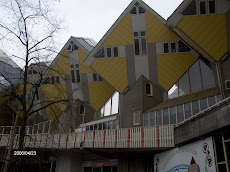Back in June I met a man through CouchSurfing. We got to talking about the Netherlands, and he asked me what I thought of when I thought of the country. So, I mentioned cheese, clogs, windmills, unilever, etc...
"No, no" he interrupted, "the best representation of the Netherlands is the way we handle the water."
He started talking about the Delta Works, Haringvliet and Maeslantkering. It sounded very interesting to me, and he offered to take me for a visit to one of these representations of the Netherlands at some point. So, this weekend we finally had our chance to go visit Maeslantkering, and I could see what could possibly make him so excited.
Maeslantkering is the last of the Delta Works, a series of projects launched after the great flood of 1953 in which almost 2000 Dutch people died. It was left to the last, because all the other water ways could be shut off by simpler dams, while the Nieuwe Waterweg is the approach to the Port of Rotterdam, where one ship every seven minutes passes through. To shut it off, or replace it with a series of locks would be very damaging to the Dutch economy. So, in the late 1980s the Dutch government asked for bids to create a wall that could be moved across the mouth of the Nieuwe Waterweg in the event of a storm surge. It also had to be built without restricting traffic on the river. The Maeslantkering was the winning bid.
It is really an impressive stucture. On each side of the river is a huge joint, about 10m in diameter. The joint is sunk into a huge pocket of concrete, so that it can resist large pressure put against it. The joint is much like a shoulder joint. It can move up and down, and side to side. Connected to the joints are large steel arms, each one the size of the Eiffel tower, and twice as heavy. The arms couldn't be made in one piece, but had to be brought in in pieces and welded together. Each weld took over 100 hours and 100 layers to finish. They are also each coated in paint in the amount that could fit in half of an olympic swimming pool. The arms were covered in white paint, so that in the sun the steel wouldn't expand as much. If they had used black paint the steel had the potential to expand the diamater of each tube by half a metre. With the white paint it is only around 9cm. On the end of each arm is a large curved wall. The curved wall is 22m tall and 210m long. At the end of each wall, next to the river is a locomotive, which is used to move the wall out into the river. Once the wall is moved out into the river, there is still space between the bottom, and the riverbed. This creates a really fast current which sweeps all the sediment out of the way, exposing the concrete blocks on the bottom of the river. The wall then sinks down.
The structure is completely computerized. The wall will only move on the say so of the computer, and that will only happen when the sea level rises more than 3m. Not at 2.99m, only at 3m. When it was built it was expected that, aside from a yearly test, the wall would only have to be closed once every 7 years, and in the future with rising sea levels, once every 5 years. Since it's completion in 1997, the wall has only been closed once because of rising sea levels. Unfortunately, when I asked, they wouldn't close it so that I could see what it looked like closed...
Giving Back...with time, photos, and smiles
14 years ago

2 comments:
Did you memorize all those facts?
maybe just a bit...
Post a Comment